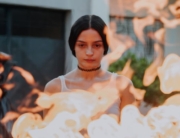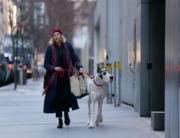![]() If we achieve a life devoid of trauma with the aid of advanced technologies, what would we ultimately become? What would we lose or give up? In the classic vein of science fiction, Bertrand Bonello has created The Beast, a singular work that, with nods to romantic melodrama, reflects on why the attainment of a future without conflicts or calamities could end up becoming the ultimate betrayal against our humanity, a catastrophe barely better than total extinction.
If we achieve a life devoid of trauma with the aid of advanced technologies, what would we ultimately become? What would we lose or give up? In the classic vein of science fiction, Bertrand Bonello has created The Beast, a singular work that, with nods to romantic melodrama, reflects on why the attainment of a future without conflicts or calamities could end up becoming the ultimate betrayal against our humanity, a catastrophe barely better than total extinction.
Loosely adapted from the Henry James novella The Beast in the Jungle, the French director, co-writing with Guillaume Bréaud and Benjamin Charbit, depicts something more than a dystopian reality. He flirts with multiple genres for three stories set in different eras, though The Beast is not an anthology. The unpredictable editing establishes connections between motifs (pigeons, dolls, sessions with fortune tellers, the opera Madame Butterfly), dialogue, and characters (two would-be lovers who are unable to consummate their passion) as part of a metaphysical adventure. Bonello embraces Brechtian distancing techniques, philosophical questions, provocative imagery, and breaks in rhythm and structure. You probably haven’t see anything quite like it.
The concept sustaining the arbitrary crossing of time lines is rooted in science fiction. In the near future of 2044, artificial intelligence has advanced enough to exert benign control. Humans are officially recognized as “useless people,” in the words of an AI assistant, and emotions are considered a burden that must be purged. To fit in and qualify for good jobs, individuals must undergo a review of their past lives that allows the purification of DNA from strong feelings: traumas, unique commotions like falling in love. Two complete strangers, Gabrielle (Léa Seydoux) and Louis (George MacKay, in a role originally intended for the late Gaspard Ulliel), have begun the process, without suspecting they are connected by tragic events related to previous lives. (Seydoux completely immerses herself in this demented and sprawling epic romance about missed opportunities.)
In 1910, Gabrielle and Louis meet at a high society party in Paris. It is not their first encounter, though. She hesitates to admit that she remembers meeting him casually years ago in Italy. She is now married, although she had earlier sworn never to fall in love; Gabrielle lives with the feeling that “a beast lurks in the shadows,” a fatal premonition that “something great and terrible” would happen to her if she did. Her staid marriage has not changed her position. This time period is shot on film and resembles a cross between The Age of Innocence’s restraint and the exuberance of Titanic. It includes a spectacular scene in which a factory fire traps Gabrielle and Louis in the midst of a flood. (The other eras were shot on digital.)
A century later in 2014, Gabrielle is now a model and aspiring actress living in Los Angeles, shooting frivolous commercials in front of green chroma or dancing alone in a nightclub when not bored in the luxurious mansion where she’s house-sitting. Her path crosses with George, a sinister YouTuber whose videos and behavior express deeply misogynistic ideas pervaded by an incel mentality, in which adult men, usually virgins, blame society and women for their “involuntary celibacy.” Their collision is more reminiscent of a slasher movie than a romance. This iteration of George is clearly modeled on the manifesto of the mass murderer Elliot Rodgers, which will undoubtedly generate controversy. Although this may initially appear as an attempt at gratuitous provocation (while MacKay shines best as an actor in this role), it ultimately contributes to expanding the themes of alienation and insensitivity that the film constantly addresses as a warning. Yet in the third time setting—in antiseptic and conformist 2044—there still may be a chance for Gabrielle and George to finally admit their love for each other and fulfill their destiny to end up together.
If narratively The Beast is impressive in terms of the scope of its vision, Bonello ensures that the execution lives up to its ambition. He unleashes his most cynical and postmodern side in the 2014 passages, playing with the meta-fictional nature of images and sounds in a way that would make fans of De Palma drool. When it comes to the sci-fi aspect, his staging doesn’t aim for Hollywood blockbuster grandeur. It aligns more with the deconstructed minimalism of the French New Wave (Godard’s Alphaville, Truffaut’s Fahrenheit 451, Resnais’s Last Year at Marienbad).
With a running time of 145 minutes, The Beast takes its time to seduce you and may require multiple viewings to better absorb its visual and emotional recurrences, but some will find it excruciating right away. However, Bonello’s best film yet will cast a spell in those ready to embrace its excesses and seriously engage with its theme on how terrifying it would be to live in a world where love is easily disposable.
The Beast premiered in competition at the Venice Film Festival and had its U.S. premiere at the New York Film Festival. (Its commercial release is slated for 2024).

















Leave A Comment